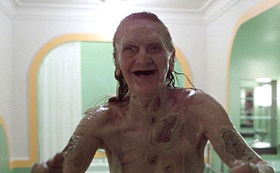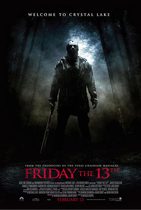Our editor-in-chief Nate Yapp is proud to have contributed to the new book Hidden Horror: A Celebration of 101 Underrated and Overlooked Fright Flicks, edited by Aaron Christensen. Another contributors include Anthony Timpone, B.J. Colangelo, Dave Alexander, Classic-Horror.com's own Robert C. Ring and John W. Bowen. Pick up a copy today from Amazon.com!
The Disused Fane: Never Meant for the World of the Living
For my money, The Shining (1980) is the scariest movie ever made, and the book is frightening as well. There are numerous reasons for this, but one of the main ones is that damn woman in Room 237 (217 in the book). When Danny foolishly enters the room, the film cuts away, and later it is left ambiguous who put those marks on his neck. The film does this to heighten the psychological tension that results from Wendy's suspicion of Jack. The book, however, is pretty unambiguous. Danny sees a dead, decaying woman rising from the bathtub and stumbles away in terror; huddled against a wall, he closes his eyes and reminds himself that she will go away in a little while, like a dream, when he opens his eyes; and that ghosts, the residues left by the dead, can't actually hurt living people. And then fingers begin to close around his throat...
The ancient religion of Zoroastrianism, once widespread throughout the Persian Empire and nearby lands, posited a dualistic philosophy in which the world was seen as a battleground between good and evil forces. Life was the work of Ahura Mazda, lord of light and good, whereas death and the dead were associated with Ahriman, the god of evil. Proper disposal of the dead was therefore not just a matter of personal grief and public sanitation, but a sacred duty in the struggle against the forces of darkness. The Zoroastrians feared to pollute earth, water, or even fire with corpses. The dead thus were placed in open-air "towers of silence" to wither of exposure and be picked clean by birds. Their bones would then be entombed within the tower to be dissolved by lime and the elements.1
Interestingly, Zoroastrianism ascribed the process of putrefaction in cadavers to a "corpse demon" which, as soon as life was gone, leapt into the body to spread evil and contamination.2 Any horror movie involving the undead might be said to be operating on much the same idea, but the Evil Dead trilogy (1982, 1987, 1992) in particular comes to mind. Ash and his friends stumble across the "Book of the Dead", which, as the narration in the latter two films explicitly tells us, was never meant for the world of the living. Recitation of its forbidden passages calls forth dark spirits. Angry at having been carelessly awoken, they seek to possess the bodies of the living. If the victim is still alive at the time of possession, she almost instantly begins to resemble a corpse - pale skin, colorless eyes, dead grey hair, rigor-mortis grin. A wound inflicted by one of the demonic zombies can (in some but not all cases) spread their supernatural corruption to the wounded. And those who have just died, being defenseless, are especially ripe for possession. The only way to stop the "evil dead" is to dispose of the bodies properly... which, in this case, means hacking them to pieces with an axe or a chainsaw.
Elsewhere in the Middle East (a region of warm temperatures, where corpses do not "keep" for very long), the ancient Hebrews had their own ideas about keeping the living and the dead separated in an appropriate, respectful, and health-conscious fashion. During the First and Second Temple periods in Israel, the complex ceremony of the Red Heifer was sometimes performed to ritually purify persons who had been contaminated by contact with the dead. The sacrificial heifer was burned, and its ashes mixed with pure water to be sprinkled on the person in question. Before the ceremony the heifer and the priests took a special route to avoid graves (the Hebrew word "sheol", sometimes translated as "Hell", actually means "grave"), and the water for the ceremony was brought by special children who were raised in isolation from corpses. The priests who performed the ritual were then themselves considered impure until bathed and cleansed. In modern Orthodox Judaism it is still customary to wash the bodies of the deceased with pure water.3
During the climactic sequence of Ringu (1998), reporter Reiko Asakawa descends into the forgotten well where the girl Sadako's corpse lies. She and ex-husband Ryûji Takayama believe that, if the corpse is dealt with properly, Sadako's ghost will be placated. The scariest part of this particular scene unsurprisingly involves Reiko's finding what she seeks - a lock of black hair, floating in the stagnant water like seaweed, soon found to be loosely attached to a skull with slime pouring from its eyes. It's scary, because few of us much care for the idea of coming into such close contact with human remains, particularly when they've been treated so disrespectfully, and with such gross results. And scarier still is Sadako's ongoing revenge - in which her disembodied ghost commits its own transgression of the life-death boundary by physically killing her victims, making them too into corpses requiring the funeral services of the living.
The Shining's Overlook Hotel is a place where many murders and tragic deaths have occurred. One wonders how long the various pieces of Mr. Grady's daughters lay hacked-up in the hall, or how long the woman in Room 237 lay strangled and putrefying in her bath, before someone discovered them. If indeed their spirits lived on, they could not have been terribly happy about the ignominy visited on their mortal remains, any more than the people who had to deal with said remains - made impure after time through possession by bacteria. Our almost preternatural knowledge that certain things must be done with corpses can mostly be explained by such simple science. Everyone knows that untended cadavers spread disease. But still there remains that undercurrent of superstitious dread. We must handle the dead, depressing or distasteful though it may be, for their good and for ours, for still lurking in the backs of our minds is the fear that if we handle them improperly, they might come back to return the favor.
- Modi, Jivanji J. "The Funeral Ceremonies of the Parsees". Journal of the Anthropological Society of Bombay, 1922. Web. Retrieved 28 November 2010. <http://www.avesta.org/ritual/rcc.htm>. (back)
- Brodd, Jeffrey. World Religions. Winona, MN: Saint Mary's Press, 2003. Print. (back)
- Richman, Rabbi Chaim. The Mystery of the Red Heifer: Divine Promise of Purity. Jerusalem: Rabbi Chaim Richman, 1997. Web. Retrieved 28 Nov 2010. <http://www.templeinstitute.org/red_heifer/red_heifer_contents.htm> (back)









I admire the restraint you've
I admire the restraint you've shown by not mentioning zombie movies. Zombies stand in for a lot of anxieties, but I never considered them as vehicles of revenge on the living for the mishandling of their remains. Maybe zombies as the return and reinforcement of cultural tradition in the form of angry flesh-eating ancestors? I can imagine that ideas about the afterlife would flow from simply imagining one's deceased as living again and it seems to only take another step to resurrect the dead in such a way that they want to eat your brains. Maybe a lot of burial traditions arise from our need to tend to our own anxieties about whether the dead can be satisfied and whether we'll be treated in the same manner when our time comes.